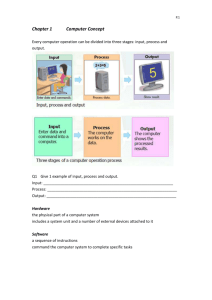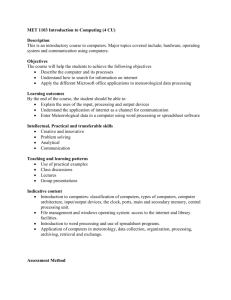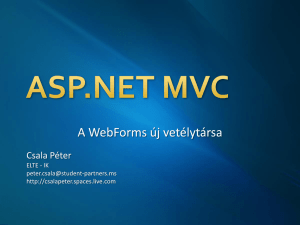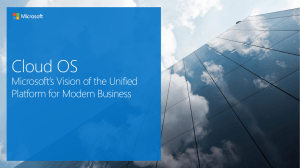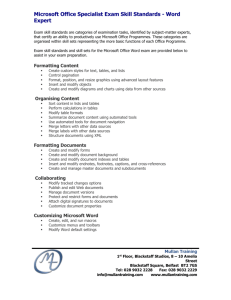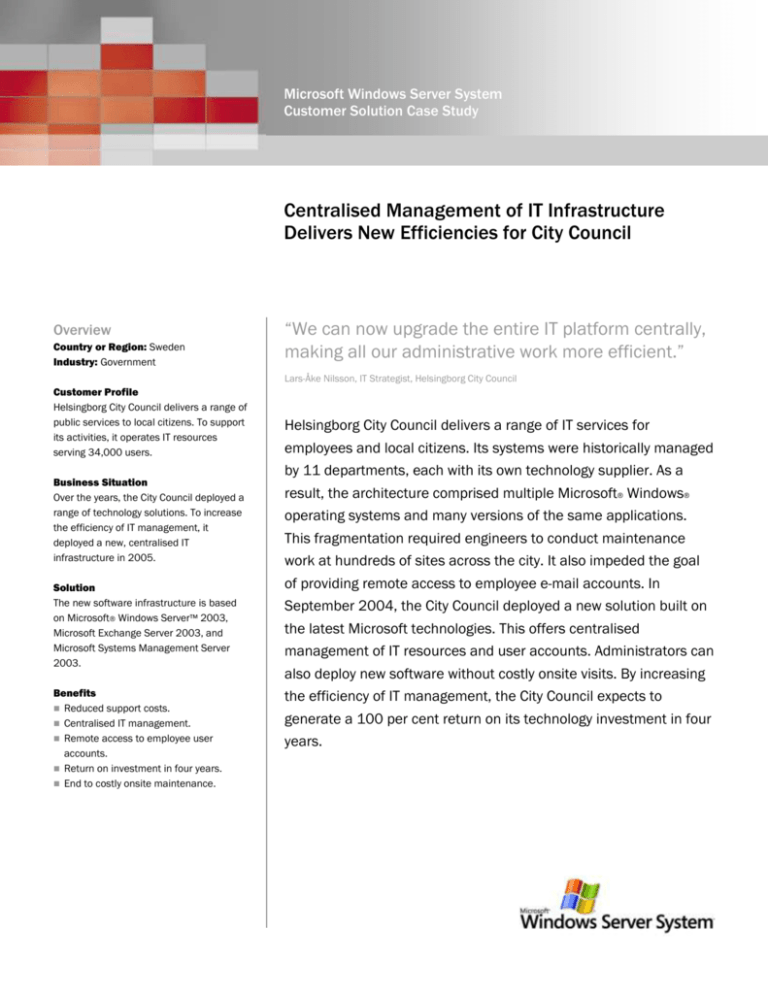
Microsoft Windows Server System
Customer Solution Case Study
Centralised Management of IT Infrastructure
Delivers New Efficiencies for City Council
Overview
Country or Region: Sweden
Industry: Government
“We can now upgrade the entire IT platform centrally,
making all our administrative work more efficient.”
Lars-Åke Nilsson, IT Strategist, Helsingborg City Council
Customer Profile
Helsingborg City Council delivers a range of
public services to local citizens. To support
its activities, it operates IT resources
serving 34,000 users.
Business Situation
Over the years, the City Council deployed a
range of technology solutions. To increase
the efficiency of IT management, it
deployed a new, centralised IT
infrastructure in 2005.
Solution
The new software infrastructure is based
on Microsoft® Windows Server™ 2003,
Microsoft Exchange Server 2003, and
Microsoft Systems Management Server
2003.
Benefits
Reduced support costs.
Centralised IT management.
Remote access to employee user
accounts.
Return on investment in four years.
End to costly onsite maintenance.
Helsingborg City Council delivers a range of IT services for
employees and local citizens. Its systems were historically managed
by 11 departments, each with its own technology supplier. As a
result, the architecture comprised multiple Microsoft® Windows®
operating systems and many versions of the same applications.
This fragmentation required engineers to conduct maintenance
work at hundreds of sites across the city. It also impeded the goal
of providing remote access to employee e-mail accounts. In
September 2004, the City Council deployed a new solution built on
the latest Microsoft technologies. This offers centralised
management of IT resources and user accounts. Administrators can
also deploy new software without costly onsite visits. By increasing
the efficiency of IT management, the City Council expects to
generate a 100 per cent return on its technology investment in four
years.
Situation
Founded more than 900 years ago,
Helsingborg is one of the oldest cities in
Sweden. It is situated in the north-west of the
Skåne province where the channel between
Sweden and Denmark is at its narrowest. The
local City Council operates 11 departments to
manage its administrative and public IT
systems, which serve 34,000 users.
Each of the operational departments
historically worked with its own IT supplier. As
a result, the City Council deployed several
different technologies over the years,
complicating IT management and increasing
support costs.
"At the time of the last
election in 2003, the
City Council made the
strategic decision to set
up a common IT
system.”
In addition, the range of technology in place
made it difficult to set up and amend user
accounts, and deploy new software
applications centrally. Instead, engineers
were required to visit hundreds of
geographically distributed sites around the
city and conduct costly, time-consuming
maintenance work.
Lars-Åke Nilsson, IT Strategist
Helsingborg City Council
In addition to these inefficiencies, the City
Council found it difficult to provide remote
access to key IT resources. As a result,
employees were not able to access
information, such as contact details, calendar
appointments, and e-mail accounts, from
outside their offices.
To address these issues, increase service
levels, and support future growth in user
numbers, Helsingborg decided to deploy a
new, fully-integrated IT infrastructure.
Lars-Åke Nilsson, IT Strategist, Helsingborg
City Council, says: "At the time of the last
election in 2003, the City Council made the
strategic decision to set up a common IT
system.”
The infrastructure previously used by the 11
departments was all based on different
versions of the Microsoft® Windows®
operating system, so the technical staff and
users already had extensive experience of
Windows systems. It seemed a natural choice
to deploy a new, fully-centralised Microsoft
environment.
Solution
The new infrastructure, which is based on the
Microsoft Windows Server™ 2003 enterprise
operating system, went live in September
2004. This incorporates the Active Directory®
directory service, a key technology that
provides centralised management
capabilities for large-scale IT infrastructures.
Active Directory is part of Windows Server
System integrated server software.
Administrators can now configure hardware
and set up user accounts from a centralised
management console. In addition, Microsoft
Systems Management Server 2003, in
tandem with Active Directory, provides tools
for centralised software deployment across
geographically distributed locations.
These centralised management features
reduce the need for costly onsite visits and
provide new levels of visibility across all
elements of the Helsingborg IT infrastructure.
All messaging requirements at Helsingborg
are now handled by Microsoft Exchange
Server 2003. This offers fast, reliable access
to e-mail inboxes, contact details, and
calendar information. In addition, it can be
used to provide secure access to user
accounts from outside the organisation,
empowering employees to work securely from
any external Internet connection.
Before the new software was deployed, HP
helped Helsingborg City Council to design and
implement a new hardware infrastructure to
support it. The full integration of HP hardware
and Microsoft applications ensures the
smooth running of the new system.
Mikael Glanzelius, Solutions Architect, HP,
says: "The new hardware and software
infrastructures come together to form a fully
centralised disk and server solution. This is
based on common industry standards,
ensuring that it remains simple to maintain,
monitor, and extend."
Benefits
"All HP hardware is
thoroughly tested and
certified for use with
Microsoft products. This
ensures optimum
performance for the new
infrastructure and
greatly simplifies
support."
Mikael Glanzelius, Solutions Architect, HP
Increased Operational Efficiency Resulting
from Centralised IT Management
Where several systems were previously in
use, Helsingborg City Council now works with
a fully-centralised IT infrastructure. By
standardising its technology in this way, it has
streamlined systems management and
reduced support costs.
City of Helsingborg IT administrators can also
see where new software is needed and
monitor hardware performance more
effectively. Efficiencies resulting from
centralised IT management are expected to
deliver return on investment (ROI) on the new
technology investment in just four years.
Nilsson says: “We can now create new
accounts centrally and deploy new
applications without visiting geographically
distributed sites in person. In fact, we can
now upgrade the entire IT platform centrally,
making all our administrative work more
efficient.”
contact with colleagues and citizens at all
times.
Nilsson says: “Remote access to employee
user accounts has long been an important
goal for us. Now, staff can stay up to date
with their communications from off-site
locations, whether they are out attending
meetings or working from home. This
ultimately helps us deliver the best possible
services for local people and provides new
flexibility for the way the City Council
operates.”
Seamless Integration of Hardware and
Software Infrastructures Streamlines IT
Operations
Because HP hardware is designed for full
integration with Microsoft applications, the
smooth-running of the new infrastructure was
assured from day one.
Glanzelius says: "All HP hardware is
thoroughly tested and certified for use with
Microsoft products. This ensures optimum
performance for the new infrastructure and
greatly simplifies support. In addition, high
levels of integration lay the foundations for
increased collaboration and document
sharing across City Council departments.”
Glanzelius says: “As a result of the
deployment, fewer technical personnel will be
needed to manage and monitor Helsingborg's
IT systems. Instead, these employees can be
redeployed to more value-added tasks, such
as planning for future expansion.”
Centralised IT Supports New Focus on Core
Service Delivery
Because the new IT infrastructure is fully
centralised, individual departments are no
longer responsible for technology
procurement and support. As a result, they
are free to focus on their core task of
delivering public services of the highest
quality.
Remote Access for Council Employees
The new platform gives users in the city's
administrative departments access to their
Windows desktop from any Internet
connection. This supports remote working
and helps City Council employees stay in
Nilsson says: “Because the entire
infrastructure is managed centrally, public
service professionals no longer worry about
technical issues such as how much memory
is required for different machines or
processes. Where new technology resources,
For More Information
For more information about Microsoft
products and services, call the Microsoft
Sales Information Center at (800) 4269400. In Canada, call the Microsoft
Canada Information Centre at (877) 5682495. Customers who are deaf or hard-ofhearing can reach Microsoft text telephone
(TTY/TDD) services at (800) 892-5234 in
the United States or (905) 568-9641 in
Canada. Outside the 50 United States and
Canada, please contact your local
Microsoft subsidiary. To access information
using the World Wide Web, go to:
www.microsoft.com
such as workstations, are needed,
departments simply place an order with the
central IT team, allowing them to focus on
their core activities and deliver the best
possible services for local citizens.”
Microsoft Windows Server System
Microsoft Windows Server System™ is a line
of integrated and manageable server
software designed to reduce the complexity
and cost of IT. Windows Server System
enables you to spend less time and budget
on managing your systems so that you can
focus your resources on other priorities for
you and your business.
For more information about Windows Server
System, go to:
www.microsoft.com/windowsserversystem
For more information about HP products
and services, visit the Web site at:
www.hp.com
Software and Services
© 2006 Microsoft Corporation. All rights reserved. This case
study is for informational purposes only. MICROSOFT MAKES NO
WARRANTIES, EXPRESS OR IMPLIED, IN THIS SUMMARY.
Microsoft, Active Directory, Windows, the Windows logo,
Windows Server, and Windows Server System are either
registered trademarks or trademarks of Microsoft Corporation in
the United States and/or other countries. All other trademarks
are property of their respective owners.
Document published March 2006
Products
− Microsoft Exchange Server 2003
− Microsoft Systems Management Server
2003
− Microsoft Windows Server 2003

